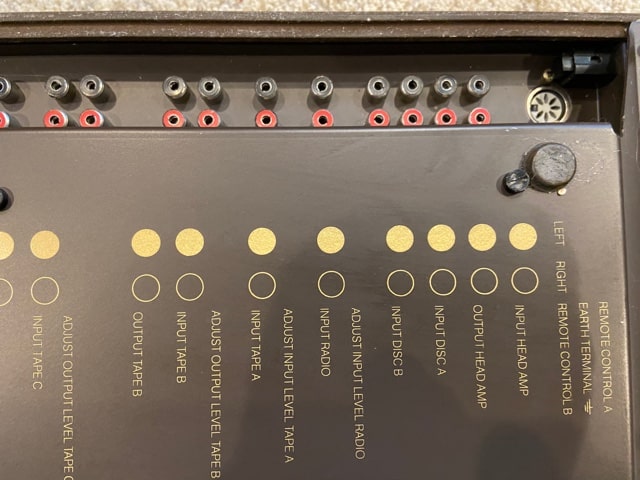
Quite a few facts here that are unknown to many.
Meridian 102.
A concept with possibly only one prototype of a stand-alone phono stage and/or step-up. Never put into production.
Meridian 101B with hard anodized finish over the raw aluminium.
An experiment to test surface-finish durability. It was indeed resistant to even a heavy set of keys being smashed down on to the surface. Never offered as an option because the process was very expensive compared to spray / power coating alternatives.
Meridian 101B brass.
This was a fun experiment. Solid brass front etched with black ink. All functions by-passed except for one single MC phono stage using the finest spec module out of the final batch off the line. Sold to Steven Daniels
Meridian MCA FM tuner.
Only a handful (UK spec only) ever built, in order to fulfill an obligation. Chances of finding one = near zero
MCA 101B in black with chrome front face etched with royal blue etching ink.
Only six were built, UK spec only. Chances of finding one = near hopeless
Meridian 107 power amp.
From left-over Zircon / Orpheus stock.
9 in total. An effortless 175 rms into 4 ohms per channel. First of the UK-designed super amps. Excellent review in the 1970s in Practical Hi-Fi & Audio used in the dealer system section. Even today, still the default / go-to / must have power amp for the Gale 401a speakers. Chances of finding one = doubtful
Meridian M1 with 4 drivers and 4 mono power amps per channel.
One pair built for me. Using same super-tweeter as Spendor BC3 ie HF2000. I should never have sold these. Chances of finding this pair = zero
Meridian 607 ADC analogue to digital converter.
Very few ever built and nearly all of them probably reside in studios where, so I am told, they are highly regarded.
Meridian CDR.
They launched this CD-R recorder in 1992, about ten years after the first CD player. It could record both digital and analogue input onto CD discs. It looks very similar to a conventional CD player, apart from the large rotary recording level knob on the left. It was priced at £4,500. Nowadays all the functions of this machine could be performed by a home computer and some cheap (or free) audio recording software. Very few ever built and nearly all of them probably reside in studios where, so I am told, they are highly regarded.
Meridian / Linn Isobaric PMS intervention.
3 pairs of 105 power amps = 3 monos per channel. Crossover-less. An outstanding concept of having the frequency response of each pair matched to the characteristics of each pair of drivers with the upper frequency response very steeply rolled off with the lower response of the next pair taking over where the lower pair finished, and so on. I commissioned 6 sets and all were very quickly sold and to my knowledge, have never appeared for sale … anywhere.
Meridian M1 speakers versus microphony.
Another experiment for Subjective Audio. In the late 1970s microphony, although audible … sometimes … was a rarely discussed topic. So we commissioned a pair with three separate power supplies for each pair of mono amps; six in total. These being connected by untidy cables (it was after all, only an experiment) and yes we certainly did experience a very worthwhile increase in bass agility / detail but not too much otherwise.
We thought we were onto … something. We were, but only partly.
We learned that at that time, each amp tray of the production M1s had only one power supply. Much of what we heard was, of course, due to the additional four supplies. Shortly after this, the dawn of digital active speakers took place, and that was that.
Finally:
Meridian 101B serial number #312744.
The very last off the production for me and built by them in Navy blue with gold lettering on the front … as a thank you.
Subsequently re-engineered by the late Colin Howard (Meridian production director) to be ONLY an MC input, all other functions being by -passed for ultimate simplicity with one pair of 1/4” studio-grade output jacks instead of RCAs .. to achieve maximum contact between plug and socket.
Used as part of an experiment by me in collaboration with Brinkmann to achieve - via my M1 actives - the ultimate fully balanced from cartridge to speakers analogue replay system - unhindered by cost - that was limited only by the sophistication of contemporary technology at that time. I still own this very, very special 101b.
The dynamics are explosive against a background of silence. Still in use here after 42 years.
© 2021 Howard Popeck






